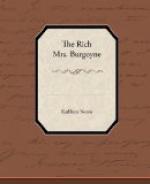The village women, coming up to the Hall, in the pleasant summer afternoons, were puzzled to find the old place almost unchanged. Why any woman in her senses wanted to live among those early-Victorian horrors, the women of Santa Paloma could not imagine. But Mrs. Burgoyne never apologized for the old walnut chairs and tables, and the old velvet carpets, and the hopelessly old-fashioned white lace curtains and gilt-framed mirrors. Even Captain Holly’s big clock— “an impossibly hideous thing,” Mrs. White called the frantic bronze horses and the clinging tiger, on their onyx hillside—was serenely ticking, and the pink china vases were filled with flowers. And there was an air of such homely comfort, after all, about the big rooms, such a fragrance of flowers, and flood of sunny fresh air, that the whole effect was not half as bad as it might be imagined; indeed, when Mammy Curry, the magnificent old negress who was supreme in the kitchen and respected in the nursery as well, came in with her stiff white apron and silver tea-tray, she seemed to fit into the picture, and add a completing touch to the whole.
Very simply, very unpretentiously, the new mistress of Holly Hall entered upon her new life. She was a woman of very quiet tastes, devoted to her little girls, her music, her garden and her books. With the negress, she had one other servant, a quiet little New England girl, with terrified, childish eyes, and a passionate devotion to her mistress and all that concerned her mistress. Fanny had in charge a splendid, tawny-headed little boy of three, who played happily by himself, about the kitchen door, and chased chickens and kittens with shrieks of delight. Mrs. Burgoyne spoke of him as “Fanny’s little brother,” and if the two had a history of any sort, it was one at which she never hinted. She met an embarrassing question with a readiness which rather amused Mrs. Brown, on a day when the two younger ladies were having tea with Mrs. Apostleman, and the conversation turned to the subject of maids.
“—but if your little girl Fanny has had her lesson, you’ll have no trouble keepin’ her,” said Mrs. Apostleman.
“Oh, I hope I shall keep Fanny,” said Mrs. Burgoyne, “she comes of such nice people, and she’s such a sweet, good girl.”
“Why, Lord save us!” said the old lady, repentantly, “and I was almost ready to believe the child was hers!”
“If Peter was hers, she couldn’t be fonder of him!” Mrs. Burgoyne said mildly, and Mrs. Brown choked on her tea, and had to wipe her eyes.
In the matter of Fanny, and in a dozen other small matters, the independence of the great lady was not slow in showing itself in Mrs. Burgoyne. Santa Paloma might be annoyed at her, and puzzled by her, but it had perforce to accept her as she stood, or ignore her, and she was obviously not a person to ignore. She declined all invitations for daytime festivities; she was “always busy in the daytime,” she said. No cards, no luncheons, no tea-parties could lure her away from the Hall, although, if she and the small girls walked in for mail or were down in the village for any other reason, they were very apt to stop somewhere for a chat on their way home. But the children were allowed to go nowhere alone, and not the smartest of children’s parties could boast of the presence of Joanna and Ellen Burgoyne.




